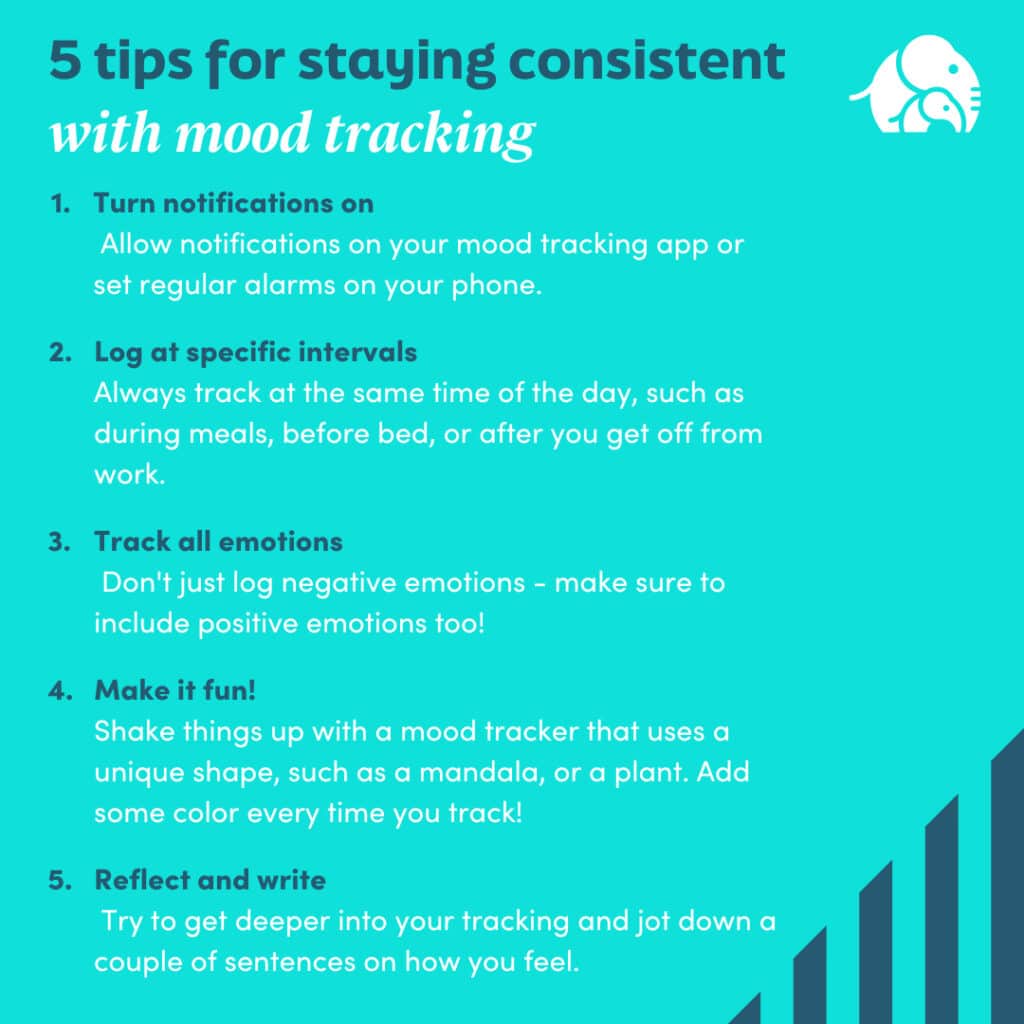Do your emotions tend to get the best of you? Everyone experiences strong emotions. However, if you find yourself frequently lashing out at people when you’re angry, withdrawing when you’re sad, or acting impulsively when you’re excited or stressed, you may struggle to react to emotions in a healthy manner.
So how can you practice more healthy emotional reactivity and emotion regulation? The first step is becoming more aware. Whether you’re looking to combat stress or manage a mental health condition, like depression or anxiety, mood tracking can help you become better attuned to your moods and how your emotions impact your behavior.
Goals of Mood Tracking
One of the main goals of mood tracking is to help you track factors that affect your mood and potentially identify mental health triggers. If you experience an intense emotional response or trauma episode and don’t know why, you won’t be able to manage that reaction in the future. However, if you know what event, person, or situation caused the episode, you can discuss this with your therapist and develop a plan on how to better cope with that situation.
Looking for a mental health partner who can help you better navigate difficult emotions? Reach out to Ellie Mental Health today.
Common Emotional Triggers
Getting a handle on emotional triggers is a big part of building self-awareness and managing your emotions. Triggers can be certain words, experiences, or situations that stir up intense feelings, often because they’re connected to past experiences or unresolved issues. When you can recognize your triggers, it becomes easier to manage your reactions and strengthen your relationships. Here are some common emotional triggers that many of us face:
- Feeling betrayed, or unwanted
- Feeling rejected or loneliness in a relationship
- Feeling as though you’re being treated unfairly
- Having your beliefs challenged
- Feelings of low self-esteem or insecurity
- Feeling frustrated or irritable
- Feeling as though you’ve done something wrong
- Being unfairly criticized or judged
Physical Symptoms of Emotional Triggers
When emotional triggers hit, they don’t just affect your thoughts—they often show up in your body, too. Physical symptoms can be the first sign that something has activated a strong emotional response, even before you’re fully aware of it. Learning to recognize these physical cues can help you pause and address the trigger before it takes over. Some common physical symptoms of emotional triggers include:
- Nervousness, anxiety, or worry
- Inability to focus or concentrate
- Sweating
- Stomach upset
- Racing heart
- Tremors
- Hyperventilating
The Benefits of Tracking Your Mood
A mood tracker helps you identify patterns in your mood and factors that affect your emotions. You may start mood tracking to better understand your emotions or to target unwanted behaviors or coping methods. You may have been asked by your therapist to start tracking moods so that they can better understand your mental health and refine your treatment plan. Here are some of the benefits of mood tracking:
- You can keep track of how you’re feeling throughout the day and note trends in how your mood fluctuates throughout the day.
- You can identify both emotional and external triggers that cause a mental health episode.
- You can take note of certain behaviors, thoughts, or coping mechanisms you use when you feel a certain way.
- You can learn how your lifestyle, diet, sleep patterns, and activity levels affect your mood.
- You can begin to predict when certain situations will lead to negative emotions and develop healthy coping mechanisms for handling them.
- You can use a mood tracker to judge if mental health treatments, such as talk therapy, EMDR, or mental health medications, are effectively stabilizing your mood.
- You can become more attuned to what factors worsen or benefit your mental health and know when to reach out for help.
Mood Tracker Options
There are several options you can consider for tracking your mood depending on your lifestyle, habits, and preferences. The most important factor is that you choose a mood tracking method that is easy for you to remember and comprehensive enough for your needs. These are just a few of the most popular types of mood trackers.
Mood Tracker Apps
If you like to keep track of your daily routine digitally, mood tracker apps can easily fit into your workflow. Smartphone apps that track your mood are a good choice if you live a busy lifestyle and are constantly on the go. Many people have their phones with them throughout the day, and phone notifications can be helpful reminders that it’s time to jot down how you’re feeling.
There are many different mood tracker apps out there to choose from, so take time to experiment with a few and find one that you find the easiest to you. You should consider the following features when picking a mood tracker app:
- Affordability: Mood tracker apps may be free, have a one-time fee, or require a membership.
- Complexity: Do you want a simple, easy-to-use app with a minimal design? Or do you want an app that has many features you can use?
- Purpose: Some mood trackers are designed to complement your self-care routine or reduce stress. Others are more popular with therapists and are used to help you track triggers for specific mental health conditions, such as bipolar disorder, depression, or PTSD.
- Shareability: If your therapist asked you to start mood tracking, you need to pick an app that makes it easy to see and share your results. Some apps will generate reports that you can easily take with you to your next therapy session.
- Multi-Purpose: Are you into daily routine apps? Do you use phone apps to track your sleep, health habits, and diet? If so, you might want to choose an app that allows you to track other activities in addition to your mood.
Mood Tracking Journal
Mood journaling can be a good mood tracker option if you prefer to spend less time on your phone or already journal regularly. You can purchase a mood journal that is designed for this very purpose, or you can start with a blank slate and log your mood the way you prefer. Using a daily planner can make it easier to keep track of the time and date. Many people also enjoy bullet journal mood tracking, which is a more visual way to track your mood on paper.
Writing in a journal by hand taps into parts of the brain that help with memory and learning in ways typing just can’t. Handwriting takes a little more time and focus, which means you’re thinking things through more deeply. All of this makes it easier to remember what you’ve written and creates a more thoughtful, personal experience than typing on a screen.
As you journal, try to stay focused on the way you are feeling. Rather than give an account of your day, strive to identify the emotion you’re feeling and why. Here are a couple of questions you can ask to guide the journal session:
- What is the name of the emotion you’re feeling?
- Did you notice a shift in your emotions?
- What do you think caused the emotion?
- What was happening around you when you felt the emotion?
- What were you thinking when you felt the emotion?
- How did you act or respond to the emotion?
- What this response appropriate for the situation?
Mood Chart
A mood chart is a visual tool for tracking your emotions. Classic mood charts are filled out daily and used to track your mood patterns over the course of a year. It features a grid where the top boxes are labeled by month and the left-hand side is numbered 1 to 31 for each day of the month. A color code is used to assign emotions a color. For each day, you need to choose the color that best represents how you felt that day and color in the corresponding box on the chart.
Mood charts come in different shapes and sizes. For example, you might see mood charts that are round or that are broken up by the hour, week, or month. Mood charts for helping kids cope with difficult emotions may use include emojis or faces to represent what different emotions look like.
Ready to get started? Try our 30 day journaling challenge today!
Tips for Staying Consistent With Mood Tracking

If you’ve started mood tracking, you might feel excited or motivated to log your emotions for the first days but find you struggle to consistently track every day. These tips can help you get the most benefit out of mood tracking and stay consistent with your chosen tracking method.
Set Notifications
As you start following the motions of your day, it’s easy to resort to your normal behaviors and forget to track your emotions. If you have a mood tracker app, it can help to allow notifications. This reminder can make a difference in your mood tracking success. If you use a mood journal or chart, set alarms to alert you when it’s time to reflect.
Log Your Emotions at Specific Intervals
Start mood tracking at specific times of the day to help make this new habit part of your routine. For example, you could always track at breakfast, after you get off work, and when you are ready to sleep.
Track the Full Spectrum of Emotions
Don’t just track how you’re feeling when something goes wrong or you’re feeling negative emotions. Make sure to note times you’re feeling excited or at peace. Identifying the things that make you happy can help you choose healthy coping methods.
Make Tracking Fun
A basic mood chart can begin to feel like a chore to fill out. To shake things up, try a mood tracker that uses a unique shape, like a mandala or a plant. Every time you fill it out you get to add a new square of color to the picture, making tracking enjoyable and rewarding.
Take Time to Reflect and Write
Try to go a little bit deeper than just tracking how you’re feeling. If you can, take the time to write a couple of sentences about your mood, triggers, and reactions. This can provide valuable insight into your mental health and makes mood tracking a more meaningful and therapeutic activity.
Once you get into the habit of mood tracking and successfully compile a log, take time to understand the results. Your therapist can also help you interpret your mood chart and teach you how you can use it in your daily life.
A mood tracker is a very useful tool for people with mental health conditions. By logging your emotions and what might have caused them, you can identify specific things that trigger your depression, anxiety, PTSD, or other condition. You can also identify how your emotions affect your behavior and better eliminate unwanted behaviors.
Struggling with regulating your emotions? The team at Ellie Mental Health can help. Get matched with a therapist near you today!


